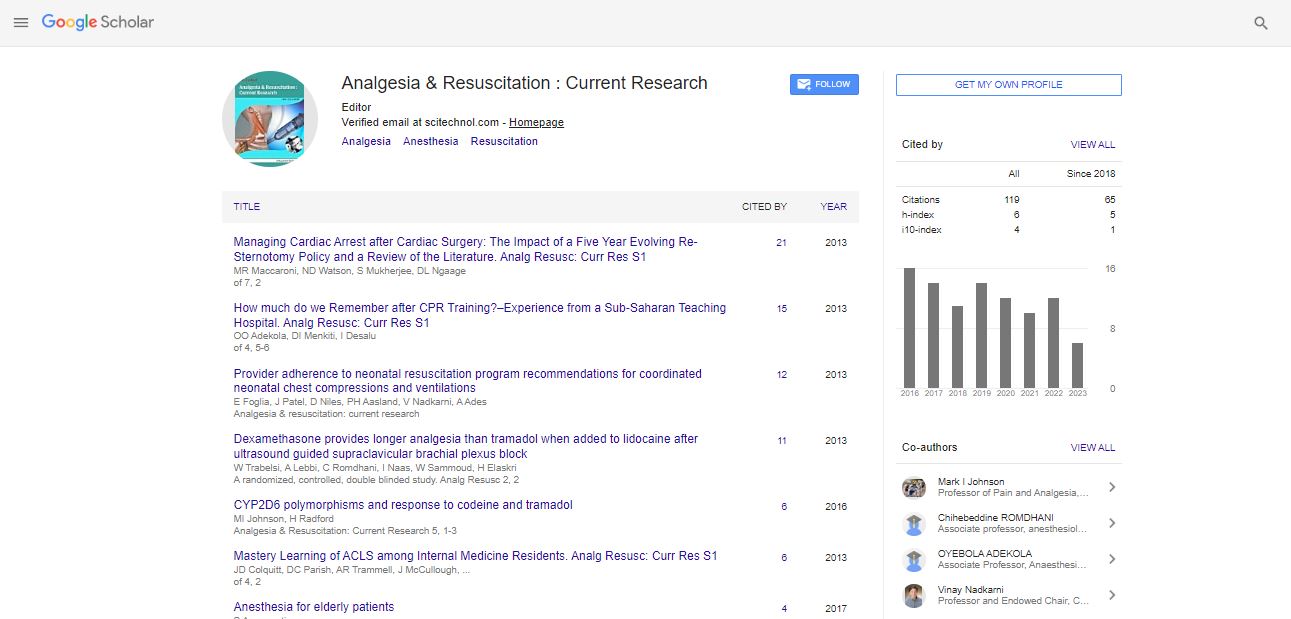Efficacy of different physical interventions in rehabilitation of medial knee osteoarthritis
Narinder Kaur Multani, Kani Mozhi D and Pragya
Punjabi University, India
: Analg Resusc: Curr Res
Abstract
Knee Osteoarthritis is one of the leading causes of disability among older patients, affecting biomechanical loading, kinesiological factors and gait mechanics. A vast body of literature has shown the efficacy of conservative physical interventions focusing on alleviating pain and improving muscle strength. However, studies exhibiting effects of these interventions in terms of improving altered knee mechanics, joint space narrowing, altered gait and deformity are scant. Therefore, present study intends to concentrate on role of foot wear alteration and application of knee brace with that of the conventional physiotherapy on clinical outcome (pain & functional status), radiographic changes, static alignment (Q– angle, Genu Varum, Tibial Torsion), kinesiological factors (Quadriceps strength, Hamstring Strength, Hamstring Flexibility, Quadriceps Lag, Knee range of Motion), gait parameters (Step Length, Stride Length, Toe-out, Cadence, Gait velocity) and plantar pressure distribution (Anterior Mask, Posterior Mask, Medial Mask, Lateral Mask) in early medial knee osteoarthritis patients. Total 90 subjects (both males & females) with medial knee osteoarthritis (Grade 2 and 3) were included in the study, with 30 subjects in each interventional group: Control group (conventional physiotherapy), Experimental Group – I (Footwear alteration along with conventional physiotherapy) & Experimental Group – II (Footwear alteration & Knee Bracing along with conventional physiotherapy). Duration of these physical interventions for all the three groups was 6 months (3 sessions /week). The results of Analysis of Variance (ANOVA), using SPSS 17.0, showed that although Conventional physiotherapy was effective in reducing pain in addition to improving functional score, hamstring strength, cadence and gait velocity; it was discouraging to observe that radiographic joint space narrowing along with asymmetry in biomechanical loading was further increased. Conversely, interventions used in both the experimental groups were effective in improving clinical outcomes, radiographic joint space width, static alignment, kinesiological factors, gait parameters and plantar pressure distribution in patients of medial osteoarthritis knee. Nevertheless, comparison of both these experimental groups revealed that concurrent use of lateral wedge and valgus brace exhibited a greater improvement in genu varum (t = 2.92, p < 0.05), tibial torsion (t = 4.39, p < 0.00), quadriceps strength (t = 2.87, p < 0.05), quadriceps lag (t = 2.05, p < 0.05), hamstring strength (F = 9.84, p < 0.00) and toe out (t = 2.67, p < 0.01) than lateral wedge alone. Thus, it may be concluded that concurrent use of lateral wedge and valgus brace along with conventional physiotherapy should be an integral part in the rehabilitation of the patients with early medial OA knee.
Biography
Narinder Kaur Multani has done Masters in Sports Medicine and Physiotherapy from Guru Nanak Dev University, Amritsar. She completed her PhD from Punjabi University, Patiala. She has more than 24 years of clinical, administrative & teaching experience and presently working as Professor in Department of Physiotherapy, Punjabi University, Patiala. Her thrust areas of research are Sports Physiotherapy, Osteoarthritis and Geriatric Physiotherapy. She has published more than 45 papers in reputed journals and has been serving as an Editorial Board Member of repute. She has authored a book entitled “Principles of Geriatric Physiotherapy”. She was the Principal Investigator of a Major Research Project on Osteoporosis funded by University Grants Commission, India.
 Spanish
Spanish  Chinese
Chinese  Russian
Russian  German
German  French
French  Japanese
Japanese  Portuguese
Portuguese  Hindi
Hindi 
